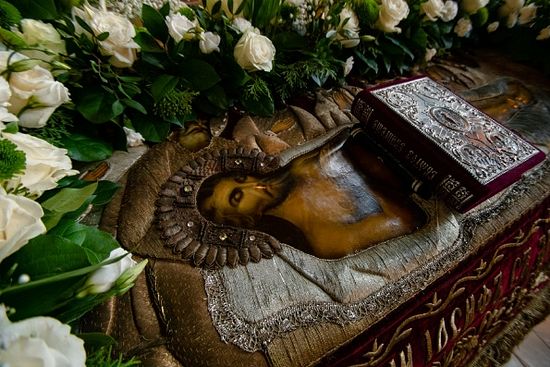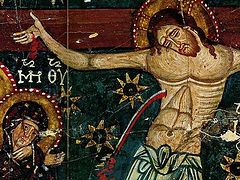The whole universe looks with awe at the Author of our faith, lifted up on high in order to lead captive the captivity holding us captive, as it says in one of the Psalms of King David, and giving gifts to men by His Resurrection; that is, pouring out the Holy Spirit upon redeemed humanity by the Blood of Christ, thereby delivering us from the works of the enemy and gathering all His scattered children into one in the Body of His Church. And in these holy hours of the Pascha of the Cross, the eyes of all are fixed upon the one Son of God, the Son of Man.
Many types and prophecies were revealed in Biblical antiquity concerning the present day and the events of the Crucifixion of Christ. One of these types is the mysterious bronze serpent, molded at the behest of the Prophet Moses and mounted on a tall staff like a cross. We remember how the ancient Jews, the Israelites in the desert were saved from certain death from the venomous bites of snakes by but one look at the image made by commandment of the Prophet Moses. So today, gazing upon the Savior, seeing in colors that which was verbally imprinted by the Evangelists, contemplating the crown of thorns and the pierced rib, hands, and feet of the Savior, nailed to the Cross in fulfillment of the ancient prophecy: They pierced My hands and my feet… and cast lots upon My vesture (Ps. 22:16, 18), looking upon the Divine Sufferer, standing before Him in quietness and silence of thought, in secret prayer to the Redeemer, we realize and feel what great rest, blessed peace, and sanctification are offered to us for the mere contemplation of the crucified Redeemer. And the more time someone spends in the church of the Lord on this day, the more clearly he feels how God gives His lifegiving grace from the Cross, healing both our spiritual and bodily wounds. Indeed, all serpents are spirits of darkness, and their venomous bites are neutralized through our worship of Christ the Savior, through prayer to Him Who is crucified, through the kissing of the thrice-blessed Tree, as our Mother the Church calls the Cross. And indeed, we learn from experience that all the mockery and torment and the bitter execution itself, preceded by the unthinkable blasphemies, insults, and sacrilege, the Savior endured with the sole purpose of restoring us to health, healing our nature fallen in Adam and multiplied by our personal sinful falls, as Isaiah the Prophet prophesied about it: With His stripes we are healed (Is. 53:5).
And every Christian, spiritually participating in these days, spiritually worshiping the Passion of the Lord, will feel in his body that mysterious sacred lifelessness expressed by the image of Christ on the Cross; will feel in his bodily and spiritual members that stillness in relation to evil, sin, and the passions that means that God is confirmed within us, raising us spiritually to the cross. The Apostle Paul proclaims this mystery of co-crucifixion with Christ, saying: If we suffer, we shall also reign with him (2 Tim. 2:12), and in another place he testifies: Be dead indeed unto sin, but alive unto God (Rom. 6:11). The holy Apostle Paul, who knew the height and depth and breadth of the mystery of the Cross, himself spiritually co-crucified and resurrected with Christ, testifies that all the children of God are called to bear this sacred deadness within themselves, having nailed the flesh—sin—with its passions and lusts to the tree of the Cross. Having crucified your members that are on the earth—that is, the passions that bring eternal death, sinful death to our soul, are weakened and dried up by the grace of God. That is why the saints could stand for hours before the Cross in silence, and they preferred the Cross to any other icon, as the most appropriate for the spiritual battle that the soldiers of Christ lead on Earth. This is why they wrote about the Savior’s wounds, calling them “the sweetest sores,” and why such a remarkable illuminator as St. Dmitry of Rostov even composed poetic works in which he spoke about how he lovingly touched the Savior’s five wounds, kissing them, watering both himself and the Cross with tears. He draws, as if drinking, the living water of grace flowing from these wounds, and especially from the bleeding rib of our Savior. Therefore, to the extent of our faith and participation in the Savior’s sufferings, we will approach this sacred image of the Savior on the Pascha of the Cross, bearing in mind that the honor rendered to it directly relates to the eternally living God, Who abides in unapproachable light.
As we depart from the Cross, let us carry Christ within ourselves, so our brows, crowned with thorns, would be free from the demonic provocation of sinful, evil, impure thoughts and images; and our hearts, spiritually pierced and sanctified by the blood of the Savior, would no longer be a den of lust, pride, or human malice, but would be opened, exuding humility, meekness, peace, love, patience, and especially that it would be welcoming of any animate image of God, as the Savior demands of us: Children, love one another … By this shall all men know that ye are my disciples, if ye have love one to another. Departing from the Cross, let us be aware that our hands and feet are nailed to the cross, so we would never encroach upon another, never walk in the paths of evil; and so our bellies, dead to lasciviousness, to excess, and, in a word, our whole body, sanctified by the sufferings of the Savior, would be an obedient instrument of the rational soul—that we would, in the expression of the Apostle, glorify the Lord in both our soul and body—for the body is not made for lust, but for the Lord, and the soul is the rational organ that should compose within itself spiritual songs and hymns, glorifying the name of the Lord Jesus. Thus, walking in the flesh, but not according to the flesh, as the Apostle says, being dead to sin, but living for God and good works, let us always have within ourselves, comprehend, and experience the mystery of the lifegiving death and Resurrection of Christ—of death as abstinence from sin, and life as a mysterious union with Life itself—the Savior—life which is, above all, known in a prayerful appeal to Christ, Crucified and Risen.




